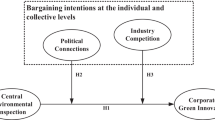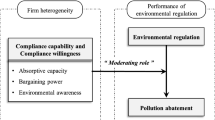Abstract
Using a unique dataset of publicly listed companies in China, we show that the collaborative environmental governance between the central and local governments reduces the effect of local enforcement of regulations on firms’ environmentally responsible behaviors. This is consistent with the fact that the Chinese central government uses a command-and-control type of regulations under which the local governments bear the full cost of enforcing the regulations. The local governments do not have the incentive to override the central supervision and therefore, simply lower their standard of enforcement and comply with the central supervision. However, this finding mainly reflects the results from the state-owned enterprises. For the private firms, the central supervision instead strengthens the impact of local enforcement. The heterogeneous results can be explained by the fact that the private firms are more financially constrained compared to the state-owned enterprises. They have the incentives to avoid the costs of complying with the regulations by paying a fine or colluding with the local regulators. The central supervision reduces the asymmetric information and increases the non-compliant firms’ chance to get caught for violations or collusion. This explains why once the central government intervenes, those private firms have to improve their environmentally responsible behaviors.
Similar content being viewed by others
Data availability
Data and codes are available from the authors upon requests.
Notes
Huang (2003) provides the tax rates that the local governments impose on firms for city maintenance, natural resource conservation, and education, etc. in 1995. The SOEs of the manufacturing sector pay 0.86% of the sales while the private firms pay 1.03%. The SOEs of the electronic sector pay 0.33% while the private firms pay 1.29%. This is regarded as a subsidy that the local governments implicitly offer to the SOEs after bargaining.
Using data on public and private entities’ compliance with the U.S. Clean Air Act and Safe Drinking Water Act, Konisky and Teodoro (2016) find that, compared with private firms, government agencies are less likely to be penalized for violations.
The pollution-intensive industries defined by the Ministry of Ecology and Environment of China include thermal power generation, iron and steel, cement, electrolytic aluminium, coal, mineral exploitation, metallurgy, chemical materials, petrochemical materials, building materials, paper and pulp, brewery, pharmaceutical products, fermentation, textiles, and leather products.
This reverse causality is not a concern for the local enforcement because the measure of local enforcement is constructed by the local regulator’s monitoring and inspection activities. It is the local regulator’s legal obligations to take these activities as their routine work. It is not influenced by how individual firms behave.
According to the NSMF program, water pollution includes the pollutant of Chemical Oxygen Demand (COD) and Ammonia Nitrogen (NH3-N), and air pollution includes Sulfur Dioxide (SO2) and Nitrogen Oxides (NOX).
Blundell and Dias (2000) propose both parametric and non-parametric matching estimators. The non-parametric approach estimates the average treatment effect on the treated (ATT), i.e., to compare the means of the ERBs between the treated (NSMF participants) and the controls (non-participants). However, the goal of this paper is to test the causality of the collaborative environmental governance on the firms’ ERB. Therefore, we use the parametric approach instead of analyzing the ATT.
References
Angrist JD, Pischke JS (2008) Mostly harmless econometrics: an empiricist’s companion, 1st edn. Princeton University Press, New Jersey
Bai CE, Hsieh CT, Song ZM (2016) The long shadow of a fiscal expansion. Brookings Papers on Economic Activity, pp 129–165
Banzhaf HS, Chupp BA (2012) Fiscal federalism and interjurisdictional externalities: new results and an application to US air pollution. J Public Econ 96(5):449–464. https://doi.org/10.1016/j.jpubeco.2012.01.001
Blundell R, Dias MC (2000) Evaluation methods for non-experimental data. Fisc Stud 21:427–468. https://doi.org/10.1111/j.1475-5890.2000.tb00031.x
Cai H, Fang H, Xu C (2011) Eat, drink, firms and government: an investigation of corruption from the entertainment and travel costs of Chinese firms. J Law Econ 54(1):55–78. https://doi.org/10.1086/651201
Carlsson F, Kataria M, Lampi E (2011) Do EPA administrators recommend environmental policies that citizens want? Land Econ 87(1):60–74. https://doi.org/10.3368/le.87.1.60
Chang HF, Sigman H, Traub LG (2014) Endogenous decentralization in federal environmental policies. Int Rev Law Econ 37:39–50. https://doi.org/10.1016/j.irle.2013.07.001
Chen CS, Yu CC, Hu JS (2018) Constructing performance measurement indicators to suggested corporate environmental responsibility framework. Technol Forecast Soc Chang 135:33–43. https://doi.org/10.1016/j.techfore.2017.05.033
Cole MA, Elliott RJ, Wu S (2008) Industrial activity and the environment in China: an industry-level analysis. China Econ Rev 19:393–408. https://doi.org/10.1016/j.chieco.2007.10.003
Cong LW, Gao H, Ponticelli J, Yang X (2019) Credit allocation under economic stimulus: evidence from China. Rev Financ Stud 32:3412–3460. https://doi.org/10.1093/rfs/hhz008
De Loecker J (2007) Do exports generate higher productivity? Evidence from Slovenia. J Int Econ 73:69–98. https://doi.org/10.1016/j.**teco.2007.03.003
Dean JM, Lovely ME, Wang H (2009) Are foreign investors attracted to weak environmental regulations? Evaluating the evidence from China. J Dev Econ 90:1–13. https://doi.org/10.1016/j.jdeveco.2008.11.007
Dehejia RH, Wahba S (1999) Causal effects in non-experimental studies: reevaluating the evaluation of training programmes. J Am Stat Assoc 94:1053–1062. https://doi.org/10.1080/01621459.1999.10473858
Dehejia RH, Wahba S (2002) Propensity score-matching methods for nonexperimental causal studies. Rev Econ Stat 84:151–161. https://doi.org/10.1162/003465302317331982
Dollar D, Wei S-J (2007) Das (Wasted) Kapital: firm ownership and investment efficiency in China. IMF Working Papers 07/9. https://doi.org/10.5089/9781451865738.001.
Elliott RJR, Jabbour L, Vanino E (2020) Innovation and the creative destruction of trade: a study of the intensive and extensive margins of trade for French firms. Oxf Bull Econ Stat 82(1):180–208. https://doi.org/10.1111/obes.12324
Estrin S, Perotin V (1991) Does ownership always Matter? Int J Ind Organ 9(1):55–72. https://doi.org/10.1016/0167-7187(91)90005-6
Evans MF (2016) The clean air act watch list: an enforcement and compliance natural experiment. J Assoc Environ Resour Econ 3(3):627–665. https://doi.org/10.1086/686295
Evans MF, Stafford SL (2019) The clean air act watch list and federal oversight of state enforcement efforts. J Environ Econ Manag 93:170–184. https://doi.org/10.1016/j.jeem.2018.12.003
Fisman R, Svensson J (2007) Are corruption and taxation really harmful to growth? Firm level evidence. J Dev Econ 83:63–75. https://doi.org/10.1016/j.jdeveco.2005.09.009
Gao Y (2009) Corporate social performance in China: evidence from large companies. J Bus Ethics 89(1):23–35. https://doi.org/10.1007/s10551-008-9982-y
Ghanem D, Zhang J (2014) ‘Effortless perfection’: Do Chinese cities manipulate air pollution data? J Environ Econ Manag 68(2):203–225. https://doi.org/10.1016/j.jeem.2014.05.003
Greenstone M, He G, Jia R, Liu T (2022) Can technology solve the principle-agent problem? Evidence from China’s war on air pollution. Am Econ Rev Insights 4(1):54–70. https://doi.org/10.1257/aeri.20200373
Hansen S, McMahon M, Prat A (2017) Transparency and deliberation within the FOMC: a computational Linguistics approach. Q J Econ 133:801–870. https://doi.org/10.1093/qje/qjx045
Hao C (2006) Development of financial intermediation and economic growth: the Chinese experience. China Econ Rev 17(4):347–362. https://doi.org/10.1016/j.chieco.2006.01.001
He G, Wang S, Zhang B (2020) Watering down environmental regulation in China. Q J Econ. https://doi.org/10.1093/qje/qjaa024
Hering L, Poncet S (2014) Environmental policy and exports: evidence from Chinese cities. J Environ Econ Manag 68:296–318. https://doi.org/10.1016/j.jeem.2014.06.005
Huang YS (2003) One country, two systems: foreign-invested enterprises and domestic firms in China. China Econ Rev 14:404–416. https://doi.org/10.1016/j.chieco.2003.09.011
Huang Y, Pagano M, Panizza U (2020) Local crowding-out in China. J Finance 75(6):2855–2898. https://doi.org/10.1111/jofi.12966
** H, Qian Y, Weingast B (2005) Regional decentralization and fiscal incentive: federalism, Chinese style. J Public Econ 89:1719–1742. https://doi.org/10.1016/J.JPUBECO.2004.11.008
Kahn ME, Li P, Zhao D (2015) Water pollution progress at borders: the role of changes in China’s political promotion incentives. Am Econ J Econ Pol 7(4):223–242. https://doi.org/10.1257/pol.20130367
Kleymenova AV, Tomy R (2020) Observing enforcement: evidence from banking. Chicago Booth Research Paper No. 19-05
Klugman J, Rodriguez FR, Choi HJ (2011) The HDI 2010: new controversies, old critiques. J Econ Inequal 9:249–288. https://doi.org/10.1007/s10888-011-9178-z
Konisky D, Teodoro M (2016) When governments regulate governments. Am J Polit Sci 60(3):559–574. https://doi.org/10.1111/ajps.12221
Laeven L, Levine R (2009) Bank governance, regulation and risk taking. J Finance Econ 93:259–275. https://doi.org/10.1016/j.jfineco.2008.09.003
Levinson A (1996) Environmental regulations and manufacturing location choices: evidence from the census of manufactures. J Public Econ 62(1):5–30. https://doi.org/10.1016/0047-2727(96)01572-1
Lin C, Lin P, Song F (2010) Property rights protection and corporate R&D: evidence from China. J Dev Econ 93:49–62. https://doi.org/10.1016/j.jdeveco.2009.04.006
Maddala GS, Lahiri K (2009) Introduction to econometrics, 4th edn. Wiley
Pal R, Rathore U (2016) Estimating workers’ bargaining power and firms’ markup in India: implications of reforms and labor regulations. J Policy Model 38(6):1118–1135. https://doi.org/10.1016/j.jpolmod.2016.09.002
Poncet S (2005) A fragmented China: measure and determinants of Chinese domestic market disintegration. Rev Int Econ 13(3):409–430. https://doi.org/10.1111/j.1467-9396.2005.00514.x
Rosenbaum PR, Rubin DB (1983) The central role of the propensity score in observational studies for causal effects. Biometrika 70:41–55. https://doi.org/10.1093/biomet/70.1.41
Schelling TC (1956) An essay on bargaining. Am Econ Rev 46(3):281–306
Shen Y, Hueng CJ, Hu W (2021) Measurement and spillover effect of digital financial inclusion: a cross-country analysis. Appl Econ Lett 28(20):1738–1743. https://doi.org/10.1080/13504851.2020.1853663
Shleifer A, Vishny RW (1997) A survey of corporate governance. J Finance 52(2):737–783. https://doi.org/10.1111/j.1540-6261.1997.tb04820.x
Terza JV, Basu A, Rathouz PJ (2008) Two-stage residual inclusion estimation: addressing endogeneity in health econometric modeling. J Health Econ 27(3):531–543. https://doi.org/10.1016/j.jhealeco.2007.09.009
Wang H, ** Y (2007) Industrial ownership and environmental performance: evidence from China. Environ Resour Econ 36:255–273. https://doi.org/10.1007/s10640-006-9027-x
Wang H, Wheeler D (2003) Equilibrium pollution and economic development in China. Environ Dev Econ 8(3):451–466. https://doi.org/10.1017/S1355770X030024X
Wang H, Wheeler D (2005) Financial incentives and endogenous enforcement in China’s pollution levy system. J Environ Econ Manag 49(1):174–196. https://doi.org/10.1016/j.jeem.2004.02.004
Wang H, Mamingi N, Laplante B, Dasgupta S (2003) Incomplete enforcement of pollution regulation: bargaining power of Chinese factories. Environ Resour Econ 24:245–262. https://doi.org/10.1023/A:1022936506398
Wang L, Wang Y, Zhou J (2022) Political connection, government R&D subsidies and innovation efficiency: evidence from China. Finance Res Lett 48:102953. https://doi.org/10.1016/j.frl.2022.102953
Williams RC (2012) Growing state-federal conflicts in environmental policy: the role of market-based regulation. J Public Econ 96:1092–1099. https://doi.org/10.1016/j.jpubeco.2011.08.003
Wooldridge JM (2014) Introductory econometrics a modern approach, 5th edn. Cengage Learning, Singapore
Wu S, Zhang J, Elliott RJR (2023) Green securities policy and the environmental performance of firms: assessing the impact of China’s Pre-IPO environmental inspection policy. Ecol Econ 209:107836. https://doi.org/10.1016/j.ecolecon.2023.107836
Yu M (2021) Exports, productivity, and credit constraints. In: Yu M (ed) Exchange Rate, credit constraints and China’s international trade. Palgrave Macmillan, Singapore. https://doi.org/10.1007/978-981-15-7522-8_3
Zelany M (1974) A concept of compromise solutions and the method of the displaced ideal. Comput Oper Res 1(4):479–496. https://doi.org/10.1016/0305-0548(74)90064-1
Zhang B, Chen XL, Guo HX (2018) Does central supervision enhance local environmental enforcement? Quasi-experimental evidence from China. J Public Econ 164:70–90. https://doi.org/10.1016/j.jpubeco.2018.05.009
Acknowledgements
Wu acknowledges supports from the National Natural Science Foundation of China under Grant #71803193 and the Ministry of Education of China under Grant #17YJC790166.
Author information
Authors and Affiliations
Contributions
Professor Wu initiated the ideas and conducted the empirical work. Professor Hueng wrote the main manuscript text. Both authors reviewed the manuscript.
Corresponding author
Ethics declarations
Conflict of interest
There is no conflict of interest.
Additional information
Publisher's Note
Springer Nature remains neutral with regard to jurisdictional claims in published maps and institutional affiliations.
Rights and permissions
Springer Nature or its licensor (e.g. a society or other partner) holds exclusive rights to this article under a publishing agreement with the author(s) or other rightsholder(s); author self-archiving of the accepted manuscript version of this article is solely governed by the terms of such publishing agreement and applicable law.
About this article
Cite this article
Wu, S., Hueng, C.J. Central-local collaborative environmental governance and firm-level environmental performance: the role of firm ownership. Econ Gov 25, 57–80 (2024). https://doi.org/10.1007/s10101-023-00305-5
Received:
Accepted:
Published:
Issue Date:
DOI: https://doi.org/10.1007/s10101-023-00305-5
Keywords
- Collaborative environmental governance
- Environmentally responsible behaviors
- Central government interventions
- Firm ownership




